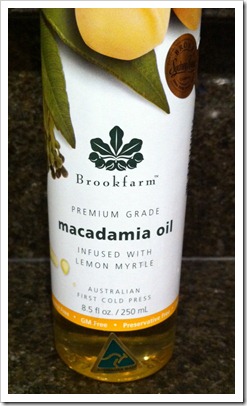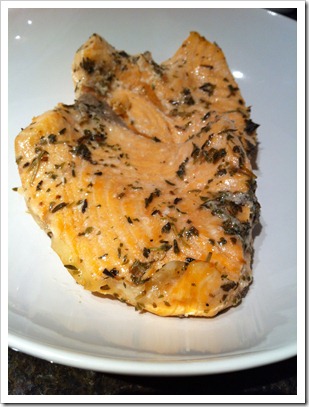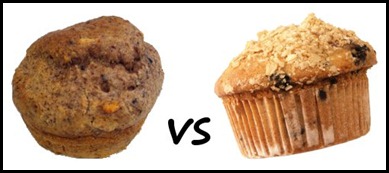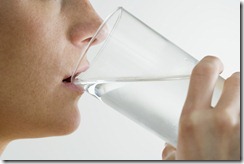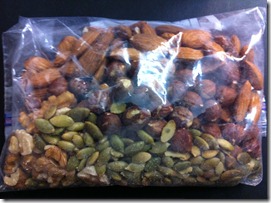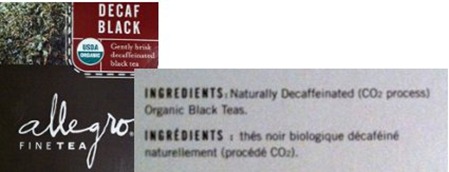Moved to AncestralChef.com
I have moved to blogging at AncestralChef.com.
Please follow me there for more delicious recipes!! If you haven’t seen my new FREE iPad e-book, then check it out on your iPad here. You can also reach me on Twitter, Facebook, Pinterest, or Google+.
I am also featured in the first issue of Paleo Living Magazine for iPad (full of videos, interactivity, and gorgeous pictures!), and you can download the first issue for FREE here.
Exercising – Hard Core Push Ups
Why I became interested in “Military-Style”
Push-Ups:
I grew up playing badminton, first at home with my parents and then more often and competitively in both high school and college. I only ever received coaching and training at an older age, which meant that I wasn’t particularly good at badminton and also that my form wasn’t very good. Over time, my bad form led to me developing shoulder injuries, mainly tendinitis in the rotator cuff of my right shoulder.
I gave up playing a few years ago, but the pain and discomfort still linger in many activities. I’ve tried Active Release Therapy with my local chiropractor (after reading about it in Tim Ferriss’ book, “4 Hour Body”), and the therapy (along with a cortisone shot) has definitely helped calm down the injury. After a year of pretty much doing nothing with my shoulder, the pain has subsided, and I have almost normal range of motion. However, the pain still comes back if I do certain exercises.
In particular, push ups give me problems – and no wonder since normal push ups often injure rotator cuffs in people without prior shoulder injuries!
As an alternative, my chiropractor suggested that I try “military-style” push-ups, which I want to share with you so that more people don’t injure their shoulders while doing pushups. (In fact, my cross-fit instructor also suggested that everyone do these instead of normal push-ups.) These push-ups also have an added benefit – they’re harder than normal push-ups, mostly because they rely on your arm muscles more than your chest! In effect, you get less injury with more of a work out….
How to do Military Style Push Ups: I was going to write a very detailed explanation, but I found the video above (on YouTube), and it explains the movement about as well as I could hope to.
The key is to keep your elbows tucked in close to your side (rather than out at right angles to your body). Your hands are generally directly under your shoulders.
The first time I tried these push ups, I nearly collapsed from doing just 5, because I was so unused to working out that part of my arms, so don’t be afraid to start with your knees on the floor or even doing the push ups against a wall. Just remember to tuck your elbows into your side, and your rotator cuffs will thank you!
Baking Soda Vs. Baking Powder–Is There a Difference?
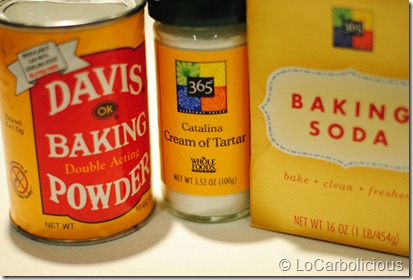 If you’ve ever baked normal (full of carbs) cookies, cakes, or breads, then you have probably used baking soda or baking powder. You might also have come across cream of tartar perhaps. These are all common ingredients that you can find in the baking section of most grocery stores. For a long time, I thought baking soda and baking powder were the same thing and could be used interchangeably. I don’t really know why I thought such a thing – but it does explain why I wasn’t particularly good at baking before!
If you’ve ever baked normal (full of carbs) cookies, cakes, or breads, then you have probably used baking soda or baking powder. You might also have come across cream of tartar perhaps. These are all common ingredients that you can find in the baking section of most grocery stores. For a long time, I thought baking soda and baking powder were the same thing and could be used interchangeably. I don’t really know why I thought such a thing – but it does explain why I wasn’t particularly good at baking before!
What is Baking Powder? This is usually a combination of baking soda with an acidic agent (such as cream of tartar, which is described below) along with some other ingredients, such as cornstarch. Baking powder produces carbon dioxide bubbles, which expand in the oven (due to the heat) so that your baked goods will rise and become light and soft. Baking powder can come in two versions: single-acting and double-acting. Single-acting means that as soon as you add the powder to anything wet, it’ll start giving off carbon dioxide bubbles, so you’ll need to put your mixture into the oven quickly to avoid running out of bubbles. Double-acting means that although some of the bubbles are released when you first add the powder to your mixture, most of the bubbles will come out when the mixture heats up in the oven. Therefore, you don’t have to worry about leaving your mixture out for too long when it comes to double-acting powder.
Why is Baking Powder Problematic on a Low Carb Diet? Many low carb diets discourage cornstarch or any other type of starch, but this is unfortunately an ingredient in most brands of baking powder. The starch doesn’t actually add much to the cooking, but it does stop the baking powder from getting moist and clumping together. So, while the baking powder states that it contains less than 1g of carb, you should remember that its serving size is 1/8 of a teaspoon and most recipes call for at least a teaspoon or more (there are 2g of carbs per teaspoon of baking powder). If you’re not super strict on your low carb diet, then a teaspoon of baking powder is not going to be a problem. However, if you’re really counting every carb, then you can make your own starch-free low carb baking powder by using cream of tartar and baking soda combined. A simple recipe for making baking powder is below, but first let me briefly explain what baking soda and cream of tartar are.
What is Baking Soda? It’s 100% sodium bicarbonate, which reacts with anything acidic in your baking mixture to produce carbon dioxide bubbles. These bubbles will start forming as soon as the baking soda touches the acidic ingredients, so you need to bake your mixture fast (otherwise, the bubbles will die out).
What is cream of tartar? This is a white powder (potassium hydrogen tartrate) that is an acidic salt. It’s occurs naturally as one of the by-products of wine-making. It has many uses in foods, the most well-known of which is stabilizing beaten egg whites. Other uses include giving icing and meringue a creamy texture (hence its name I assume) and reducing discoloration of vegetables when boiled. For low carb dieters, it has another use. When added to baking soda, it makes a carb-less baking powder that works just as well as normal baking powder! There have been some health concerns about cream of tartar. First, it is high in potassium, which can be problematic for people with kidney disease or taking medications that prevent the kidney from getting rid of the potassium effectively. When taken in large amounts, cream of tartar can also be a laxative. However, the amount used in normal cooking is generally not a problem.
What is the Paleo Diet?
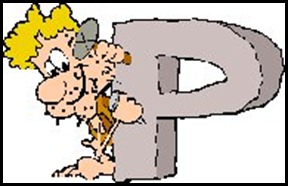 I was recently surprised to find that some of my friends who are generally health-conscious had never heard of the Paleo diet. “It’s sometimes called the ‘caveman diet’?” I replied in a questioning tone. Still no signs of recognition.
I was recently surprised to find that some of my friends who are generally health-conscious had never heard of the Paleo diet. “It’s sometimes called the ‘caveman diet’?” I replied in a questioning tone. Still no signs of recognition.
I spend a lot of time reading and writing about nutrition and diet, so it shouldn’t be surprising that my friends have not heard of certain diets with which I feel intimately acquainted. I guess my friend never read any of the articles entitled “Top 10 Craziest Diets!” (Several of which list and mock the Paleo diet, often alongside diets involving tapeworms – Yes, a tapeworm diet existed back in the 1920s – No, you should not try it)! With a nod to my friend, here is a simple explanation of the Paleo diet.
The basic idea
The Paleo diet is based on the idea that it is, in many ways, healthy to live like our ancestors millions of years ago. The DNA that defines how our bodies function evolves very slowly over a very long time. For instance, humans have really only been eating grains for the past 10,000 or so years, which is too short of a time for our DNA to have evolved to digest those foods properly (likewise, humans have only been eating refined sugars and carbohydrates for an incredibly short time). The fact, then, that modern diets are often very high in grains and refined carbohydrates leads to a variety of health problems (e.g., there have been links to diabetes, allergies, digestion disorders, and Alzheimer’s).
Although it’s often referred to as a diet, Paleo is really more of a lifestyle than a crash course for losing weight (even though weight loss often occurs when eating a Paleo diet). Therefore, it’s not just nutrition that is emphasized, but also exercise and reductions in daily stress. In general, the idea is that our food intake and weekly exercise regimes should more closely mimic that of our prehistoric ancestors. Below is a quick guide to what to eat and what to avoid as well as a description of the types of exercises done on Paleo.
What to eat and what not to eat
Ask yourself what a caveman would have eaten and you’re pretty much there! Click here for some sample meal plans.
- Vegetables are good and should be the bulk of what you eat every day.
- Meat should be consumed plentifully, although pasture-raised or grass-fed meats are encouraged.
- Good fats are highly emphasized in the diet. Good fats include animal fats (including both lard and butter), coconut oil, olive oil, macadamia oil, and avocado oil. These oils are lower in certain fatty acids that most modern diets over-emphasize.
- Some starchy/sugary foods are permitted, although in moderation. For instance, sweet potatoes and yams are both OK to eat, but they should be eaten sparsely.
- Nuts and fruits are allowed, but again only in moderation. Cavemen obviously didn’t have orchards, but they might very occasionally come across some berries and nuts.
- No grains (including oatmeal, rice, whole grains, rye, corn, cous cous, and especially wheat).
- No legumes (including kidney beans, soy beans, black eyed peas, and pinto beans).
- No processed sugars (i.e. – no added sugar in any products you buy or cook).
- Generally, no dairy products (other than butter and heavy cream).
Exercise Regime
There is great emphasis on exercise as cavemen did not sit around all day long. Neither did they jog ten miles a day on hard concrete, though. In addition to actual exercise regimes, Paleo lifestyles tend to encourage just moving around as much as possible (e.g. – walking or biking places and generally not sitting as much as possible).
Cavemen also had to engage in really intense exercise every couple days, since they had to run from predators and/or chase down and kill animals to eat. Recently, an exercise regime referred to as “Crossfit” has gained a lot of popularity among those living a Paleo lifestyle. Many crossfit gyms have sprung up in recent years to offer these regimes. The regimes often include sprinting and weight lifting in short sessions lasting maybe just 20 minutes twice a week! The workout sessions are very short but also very intense. Click here for a video of crossfit exercises.
Creative Cooking
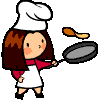 Following recipes is all very good when you have time to go shopping for ingredients and essential cooking equipment. What about when you’re hungry and just want something to eat without the hassle of going to the grocery store? Or what about when you’re moving apartments (like I did last week) and want to use up all the random foods in the fridge and cupboards? That’s when Creative Cooking comes into play!
Following recipes is all very good when you have time to go shopping for ingredients and essential cooking equipment. What about when you’re hungry and just want something to eat without the hassle of going to the grocery store? Or what about when you’re moving apartments (like I did last week) and want to use up all the random foods in the fridge and cupboards? That’s when Creative Cooking comes into play!
First, look for the main ingredients (some type of meat and/or vegetable).
First, look for the main ingredients (some type of meat and/or vegetable). I found 3 frozen salmon filets in my freezer and a can of bamboo shoots in water (which is fairly low in carbs) in my cupboard.
Second, see what kind of spices and oils (or herbs) you have to flavor the food.
Second, see what kind of spices and oils (or herbs) you have to flavor the food. I luckily hadn’t packed most of my spices and some cooking oils.
Third, determine what cooking equipment you have
Third, determine what cooking equipment you have e.g., pots, pans, oven, grill, etc. I had the oven and microwave (since they were part of the apartment) and some pots and pans.
Fourth, pick a recipe that you have most of the ingredients for – think of how to substitute for the missing ingredients if they are important
Fourth, pick a recipe that you have most of the ingredients for – think of how to substitute for the missing ingredients if they are important (i.e., ingredients that really flavor the dish). I wanted to make my salmon bake recipe, but I had no olive oil, no lemon juice, and no fresh parsley, which are 3 ingredients that really flavor the salmon. So I had to figure out some substitutes for them. I realized after a quick glance through my collection of oils that I had bought from Amazon a bottle of lemon infused macadamia oil (pictured below) a while back and never used it. This was a perfect replacement for both the olive oil and the lemon juice! And then I replaced the fresh parsley with some dried rosemary and thyme. I felt fairly confident that this would turn out ok since the recipe was pretty simple and the substitutions weren’t too crazy.
Then, I had to decide what to do with the bamboo shoots. I had never cooked bamboo shoots before and had bought the 14.8 oz can of bamboo on a whim, but I remembered eating them in Chinese restaurants with chili oil (usually as a cold appetizer). So I figured that chili and bamboo shoots went well together. I therefore decided to stir fry the bamboo shoots with some red chili flakes and hot sauce (since I had no chili sauce) and then added some minced garlic, , salt, and a touch of soy sauce for extra flavor. I was a bit apprehensive about how it would turn out, but it was delicious.
I was lucky that both dishes I made up turned out well; sometimes, it ends up being a disgusting mess. But, it’s fun to be creative, especially when it turns out well! Let me know if you’ve created any good or bad dishes recently by leaving a comment below.
The difference between low-carb and non-low-carb foods
When I shop, I like to look to see how many calories and how many carbs are in my foods. But, most of the numbers I’m used to seeing are under 10g of carbs per serving as I usually look at low carb foods. Even seeing something with 10g of carbs per serving might make me think twice before buying it! I had therefore completely forgotten just how many carbs were in non-low-carb foods!
I recently made some delicious apple cinnamon muffins, and I was interested in knowing how their nutritional values compared with Starbucks muffins. Starbucks has very helpfully provided all the information on their website.
-
An apple bran muffin from Starbucks contains 57g net carbs.
-
A comparable sized apple cinnamon muffin that I made contained 4g net carbs.
That’s a 53g difference! It’s no wonder you feel so sluggish after your Starbucks break.
A Carb-Calorie Catharsis: How to Stay Full while Shedding Fat
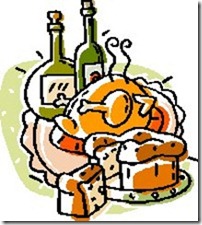 It’s holiday season once again, which is generally a good thing. Unfortunately, much of what I do during holiday season is eat, get a little fatter, and then eat some more. Evolutionarily, this was probably a good thing…our ancestors likely needed to eat more during the autumn so that they could store up fat to make it through the harsh winter when food would be less plentiful.
It’s holiday season once again, which is generally a good thing. Unfortunately, much of what I do during holiday season is eat, get a little fatter, and then eat some more. Evolutionarily, this was probably a good thing…our ancestors likely needed to eat more during the autumn so that they could store up fat to make it through the harsh winter when food would be less plentiful.
I, however, never run out of food. In fact, all I seem to lack in winter is the will to go outside when it’s cold. Thus, I simply spend more time eating in my nice warm apartment and less time doing any form of exercise. Thus, in addition to just staying healthy, I think it’s time for me to shed some fat!
I HATE Counting Calories
But when trying to lose fat, it’s the most efficient way.
I remember quite vividly some rather poor attempts on my part (when I was younger) at calorie-counting diets, and they’re not pleasant memories. The fact of the matter is that many major diets are based on calorie counting (think Weight-Watchers), and for at least some good reason: calories matter if you want to lose fat! I’m not saying that nothing else makes any difference, but the simple truth is that humans only lose weight when their bodies expend more calories than they ingest. You can change multiple parts of this equation (food intake, food absorption, metabolic rate, etc.), but calories will still matter. How then, can I go about counting calories without reliving the painful diet experiences of holidays past?
I think the answer lies in the primary failure of most low calorie diets, namely that people are almost always hungry when counting calories. And those of you who know me know that I’m not pleasant to be around when I’m hungry. So why do most low-calorie diets make us hungry?
There are a lot of actual answers to this question (a lot of which are hormonal), but the following 3 are the quite important:
- Our bodies don’t want to be in a calorie-deficit. Think about it – my survival for the immediate future always depends on having enough nourishment, and my body is evolutionarily programmed to make sure I try to eat enough. Sadly, we can’t change this fact, but we can find ways to mitigate our body’s perception that we’re starving.
- Most low-calorie diets are too low in fat and protein. Protein and fat are particularly filling (fat because it takes a while to break down in your stomach, and protein because our body can only use so much of it at a time). Moreover, if I’m not getting enough protein from my food, then my body starts finding it other places (like breaking down my muscles…).
- Most low-calorie diets don’t limit sugars and starches. For a variety of reasons, sugars and starches either fail to quench hunger or possibly make it worse. In particular, most processed grains and sugars provide practically no nutritional value, so our bodies know that we need to keep eating in order to find the proper nutrients.
In the end, a low calorie diet is always going to be at least a bit miserable, but there are ways to mitigate the pain. The best ways to make a low-calorie diet bearable are to eat enough protein and fat and limit sugars and starches…in other words, make it relatively low carb. You could eat a slice of bread that’s only 80 calories, but how many of us eat only one slice??? The urge to keep eating after that first slice is often all too tempting! I found that I generally ate fewer calories when doing the Atkins phase 1 diet, but it was much easier than just simply starving yourself because the lack of carbs made me less prone to bouts of hunger all day long.
Hence…
My Low Calorie – Low Carb Diet Plan
How many calories do you need per day? If we’re counting calories, then you need to know how many calories to eat every day in order to lose weight. Freedieting.com offers a convenient calorie calculator (it’s not perfect but it works). For me, it says that I need 1699 calories per day for maintenance and 1359 for fat loss. I know that I actually have a very fast metabolism (people are generally shocked by how much I continuously eat – especially at buffets), so I estimate my maintenance at about 1900 calories and shoot for 1500 calories to lose weight (roughly 20% below maintenance).
Calorie Counting: Once you’ve figured out what your calorie goal is, you can use MyPlate at livestrong.com to keep track of your calories. And…we’re ready for the foods!
Breakfast foods:
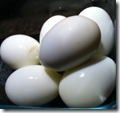 1. Egg Whites: Eggs are typically good breakfast foods. A boiled egg is only 70 calories, and a boiled egg without the yolk is only 15 calories!! You can eat 5 or 6 egg whites for breakfast while only using up 100 calories of your limit. I like to eat it with some salt or with a tablespoon of soy sauce (10 calories).
1. Egg Whites: Eggs are typically good breakfast foods. A boiled egg is only 70 calories, and a boiled egg without the yolk is only 15 calories!! You can eat 5 or 6 egg whites for breakfast while only using up 100 calories of your limit. I like to eat it with some salt or with a tablespoon of soy sauce (10 calories).
2. Protein Shakes: Another good option for breakfast is protein shakes. It’s easy and quick to make and you can get a large variety of different flavors. I like to make a simple one with 1.5 scoops of protein powder and 1/4 cup of milk or coconut milk with 8 oz of water. That’s 200 calories for the whole thing.
Snacks:
1. Low Calorie Cheeses: Luckily for us, Laughing Cow makes some tasty low calorie cheeses that are individually packaged in bite-size portions. The 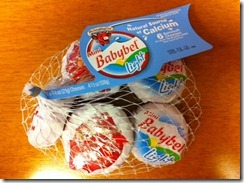
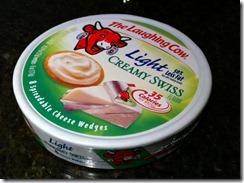 Babybel Light is 50 calories per piece (21 grams) and reminiscent of an unaged Gouda, and the Cream Swiss Light is a really a soft cheese spread that tastes very creamy, especially considering that each 21 gram wedge is only 35 calories.
Babybel Light is 50 calories per piece (21 grams) and reminiscent of an unaged Gouda, and the Cream Swiss Light is a really a soft cheese spread that tastes very creamy, especially considering that each 21 gram wedge is only 35 calories.
2. Apples and Berries: A medium sized apple with skin is around 80 calories and a cup of strawberries is around 45 calories.
3. Vegetable Sticks: Celery and zucchini are your best friends (close relatives like squash work perfectly too)! I think you can pretty much discard any calories from celery and an entire medium-sized zucchini is only 30 calories. Maybe dip in some calorie free dressing (like the ones from Walden Farm, described more below). By the way, pickles and cucumbers are also super low in calories.
Lunch/Dinner:
1. Salad: Yes, I know you feel like a rabbit eating leaves everyday, but vegetables are undeniably low in calories and high in micronutrients. Be careful not to get vegetables like corn, potatoes, chickpeas or carrots in your salad as they can raise the calories in your salad very quickly. Zucchini squash is one of my favorite things to put into a salad. One cup of sliced zucchini is only 30 calories! I find a few olives can also add a lot of flavor to the salad, although too many olives can hike up the calorie count too.
2. Salad Dressing: Low calorie dressings are hard to come by. A tablespoon of olive oil is 120 calories. I’ve always found that fact really depressing, since good olive oil makes the salad taste so much better to me. Walden Farms makes a line of calorie free dressings, but not all of them taste great. The Raspberry Vinaigrette seems to be a good safe option.
3. Grilled Salmon or Chicken: A 5oz salmon fillet is only 250 calories. You can eat it in your salad or by itself with some mustard (pretty much 0 calories) or calorie free hot sauce (I like Crystal Hot Sauce). Soy sauce, as usual, is also a good condiment to add some flavor without adding many calories. Grilled chicken is also low in calories, especially if you get it without the skin. A 5oz skinless piece of chicken breast is 150 calories. In fact, you can cook both the salmon and the chicken yourself easily on a grill (or simple, small, and cheap Foreman Grill if you’re in an apartment), and take it for your lunch.
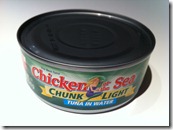 4. Tuna Salad: There are various tuna salads – you can buy them or you can make them. A can of tuna is 5oz and 100 calories and is packed with protein. I’m going to put up my favorite tuna salad recipe later this week.
4. Tuna Salad: There are various tuna salads – you can buy them or you can make them. A can of tuna is 5oz and 100 calories and is packed with protein. I’m going to put up my favorite tuna salad recipe later this week.
5: Deli Turkey Slices: I know what you’re thinking – slices of turkey meat doesn’t sound great by itself as a meal. But, it sounds more appetizing if served as part of a meat plate with some Babybel cheese, a bit of pickles, and maybe a few grapes or olives. A whole pound of Boars Head Mesquite turkey deli meat is only 480 calories, and I know I can’t eat a whole pound in one go! Like tuna, turkey is almost entirely protein.
6. Low Calorie Noodles: I wrote a post a back in August on Low Carb Pasta, and the great thing is that all those pastas were low calorie as well as low carb. Shirataki noodles (or Miracle noodles) have 0 calories and zucchini noodles are 20 calories per cup so you can eat both to your heart’s content.
Drinks
1. Diet Sodas: Obviously diet sodas have no calories, and there’s a huge variety. Be careful, though, if you find that the diet sodas make you hungrier. I personally like Vitamin Water Zero . There are also several drinks out now sweetened with Stevia instead of other artificial sweeteners.
2. Chicken Broth: This is seriously low calorie and makes me feel like I’m not just drinking water. A cup of chicken broth is just 10 calories (it varies slightly from brand to brand).
3. Almond milk: A cup of normal fat-free milk is 90 calories, but a cup of almond milk is just 40 calories, and it tastes pretty good in my opinion. It’s also good to put into protein shakes instead of milk. Just make sure you buy the unsweetened variety (it doesn’t matter if you get the original or the vanilla flavor as they both taste pretty much the same).
4. Tea and coffee: Of course, tea and coffee are both also calorie-free as long as you don’t add any milk or sugar into them.
5. Water: Remember to drink plenty of water!!!
Must I Exercise?
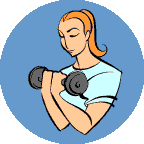 This is an entirely different post, but while I’m talking about shedding fat and counting calories, I feel like I should mention it. Unfortunately, our bodies are not as selective as we might like about whether to lose fat or muscle, so in order to lose more fat and less muscle, you should definitely put in some exercise. But don’t worry – it doesn’t need to be extremely time-consuming. No running or aerobic exercise is required (although a bit doesn’t hurt). You also don’t need to join an expensive gym or buy hardly any equipment (unless of course you want to seriously build some muscle!). Start light – buy a 5lb weight and just do some gentle arm curls with it. You can also do some push ups (do push ups against the wall to start with), sit ups/crunches, and squats. Try doing this for 15 to 20 minutes 3 times a week.
This is an entirely different post, but while I’m talking about shedding fat and counting calories, I feel like I should mention it. Unfortunately, our bodies are not as selective as we might like about whether to lose fat or muscle, so in order to lose more fat and less muscle, you should definitely put in some exercise. But don’t worry – it doesn’t need to be extremely time-consuming. No running or aerobic exercise is required (although a bit doesn’t hurt). You also don’t need to join an expensive gym or buy hardly any equipment (unless of course you want to seriously build some muscle!). Start light – buy a 5lb weight and just do some gentle arm curls with it. You can also do some push ups (do push ups against the wall to start with), sit ups/crunches, and squats. Try doing this for 15 to 20 minutes 3 times a week.
When Does the Diet End?
Although eating low carb is more of a lifestyle than a diet, counting calories thankfully need not last very long (personally, I’ll probably eat enough at Christmas to need to start all over…). Try going low calorie and low carb for 2-3 weeks and see what results you get. Don’t get discouraged if you end up cheating one day – just start again the next day. It’s too easy just to give up immediately if you stress out and eat badly one day. In fact, you can counteract the extra calories eaten during one day by eating less the next day (your body doesn’t necessarily work on 24-hour cycles). Remember, this is not a permanent lifestyle change, and you can convince yourself to do anything for 2-3 weeks!
…But, I’m on Vacation!
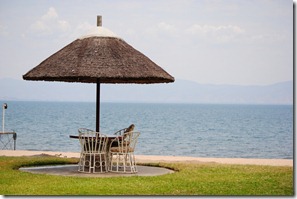 I love travelling and going on vacation. However, vacations almost always threaten to unravel months of dieting, careful eating, and general struggle (not to mention a lot of sweat and tears).
I love travelling and going on vacation. However, vacations almost always threaten to unravel months of dieting, careful eating, and general struggle (not to mention a lot of sweat and tears).
It’s super easy for me to blame the limited food options at the airport and on the planes, as well as the need to experience the full breadth of the local cuisine in other countries. Really, though, vacation not only releases me from the stresses of work, but also severs the already loose strands that tie me to a diet. And I don’t just go off the diet a bit, I got off it in a completely devastating way.
My vacations often seem to revolve entirely around eating. Where I’m eating my next meal at any given time is carefully arranged beforehand, and when I arrive at the predetermined restaurant, my eye immediately scans the menu and generally falls to the most unhealthy dish possible. Likewise, my hand detaches itself from from my brain and goes directly to the bread basket. Despite the seemingly unthinking nature of my actions, the true problem is really one of mindset – anytime I make one of these unhealthy food choices while travelling, there’s this small but powerful voice in the back of my head repeatedly chanting: “I’m on Vacation. None of this matters right now.”
Is there any hope???
Recently, I’ve decided to attack my vacation diet woes before I vacation, and you’d be astonished what a little forethought has been able to do. In general, there are 2 Things You Must Do in order to avoid reversing your dietary achievements while vacationing:
Pack Snacks for the Journey
This is, by far, the single most important thing you can do, but it’s a bit counterintuitive. After all, the amount of time you’re travelling is typically much shorter than the amount of time that you’re actually on vacation. Even so, if you start eating badly on your way to your destination, there is almost no chance that you’ll be able to convince yourself to restart your diet while you’re there. Consequently, you absolutely must pack sufficient healthy snacks and meals for your journey (whether by plane, train, or automobile).
There are a few easy snacks that you can pack for your trip – it’ll save you money on expensive and awful food as well as keep you on a low carb diet.
1. Nuts and seeds – you can easily make you own pack and sprinkle it with salt or other spices. You can see a picture (just above) of my pack for the flight (it has almonds, hazelnuts, pine nuts, and walnuts).
2. Jerky – you can buy (or make) beef or turkey jerky pretty easily. The beauty of jerky is that it will not spoil, takes up relatively little space to pack, and won’t cause a mess. In addition, it’s the most filling of the options listed here and is my personal favorite.
3. Fruits – too much fruit can be the downfall of a diet, but a few apples, pears, or similar fruit will be ok (berries are good but are tougher to pack and messier to eat).
4. Deli meat – this won’t keep for long if you don’t have some form of cooler, but it can be great as breakfast if you’re leaving early in the morning or as a snack just a few hours into your journey. Deli meat packs easily in a Ziploc bag and isn’t messy to eat in a plane, train, or car.
As I noted above, starting your trip off on an unhealthy note will only set the tone for the rest of your vacation and make it almost impossible for you to recover. That’s why it’s essential that you plan ahead for you journey. Personally, I often pack more food and snacks than I’m even able to eat on the journey – doing so forces me to eat what I’ve packed (rather than airport food), since I’ll feel slightly bad about throwing away the food I’ve packed if I don’t finish it.
This leads me to my second suggestion:
Eat Smaller Portions on Vacation
You’re in a new country or a new state, and you want to try the local cuisine. It’s partially why you took such a long and arduous trip! Or else, you’re visiting relatives or friends, and they insist on taking you out to eat at all the restaurants that offer nothing for your diet.
The best thing you can do in these situations is to simply eat smaller portions. I hate calorie-counting diets or diets where I just need to eat less, since I always end up being hungry for the better part of the day. However, this is the more realistic and easier choice on vacation, since I’m typically moving around so much and seeing and experiencing new things.
If you’re like me, you really want to try lots of different local foods. The healthier way to do this is to eat lots of variety rather than simply “eating lots”. Instead of eating a whole pizza in Chicago, eat just one slice (if you’ve never had real deep dish, take my word that one slice is plenty for most of us). Travelling abroad to China where you’ll see some delicious-looking dumplings? Order 4 different kinds and eat 1 or 2 of each. The point is not to try to avoid the local food just because it may not fit into your normal diet routine. Doing so is impossible for most of us, since it would make our vacations generally miserable. Rather, experience as much variety as you can while on vacation, but limit yourself to smaller portion sizes.
If I’m really serious about not reversing gains that I’ve made recently, then I’ll try hard to keep a rough calorie count (it’s often difficult with foreign foods, but just a rough estimate is enough). I generally try to stick to my personal maintenance amount of calories. If you don’t know your daily maintenance calories, a very rough estimate is 1800 calories/day for women or 2200 calories/day for men (or use this calculator, which provides a slightly better estimate).
Vacations should be enjoyable and relaxing, and eating is a big part of how I relax and enjoy myself. However, that doesn’t mean that I need to come back from my vacation more stressed than ever about how I’ve ruined 2 months of dieting in just 1-2 weeks. With just a little planning and forethought, my recent vacations have become much healthier and no less enjoyable. As an added benefit, I actually feel better while on vacation!! If I eat really badly, I often feel sluggish and sleep away large portions of my vacation. Eating better allows me to have more energy to do activities and generally better enjoy my time while on vacation.
How about you? Any tips for how you combat dietary sabotage while on vacation?
What’s All the Fuss about High-Fructose Corn Syrup?
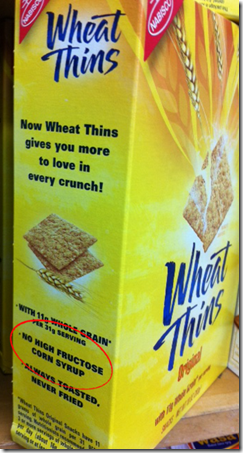 Sigh…the news these days is always depressing – this causes cancer, that causes obesity, everything shortens your life-span, and so on. One barely knows what’s safe to eat anymore!
Sigh…the news these days is always depressing – this causes cancer, that causes obesity, everything shortens your life-span, and so on. One barely knows what’s safe to eat anymore!
In that vein, we’ve been hearing a lot over the past 5 or 10 years about the “dangers” of high-fructose corn syrup, and many soft drinks and foods now specifically advertise that they don’t contain high-fructose corn syrup. So what is all the fuss about? What is high-fructose corn syrup (aren’t fructose and corn pretty natural??) and is it worse for you than other sweeteners like table sugar?
A friend recently asked me a number of questions about the differences between high-fructose corn syrup and other sugars, so I decided to do some digging. I realized that I had relatively few answers to my friend’s questions – my knowledge pretty much extended to the commercial warnings I’d heard that high-fructose corn syrup (which I shall, in very lawyerly-fashion, define as “HFCS”) was “bad” for me. And so we begin….
What is High-Fructose Corn Syrup (HFCS)?
Basic chemistry: the most common and well-known form of sugar in American households is undoubtedly table sugar, which is made from sugar cane. Table sugar is actually composed of two other sugars: 50% glucose and 50% fructose.
HFCS, like table sugar, is also composed of glucose and fructose. However, the proportions are slightly different in HFCS. The typical proportions of HFCS (as you might find in the HFCS used in soft drinks) are 55% fructose and 42% glucose (with 3% other sugar molecules ). Chemically, then, HFCS is really not that different from the white, powdery table sugar that people have used for centuries. In fact, it not very different at all from that “all-so-natural-and-healthy” honey (which also has slightly higher concentrations of fructose than glucose).
Where does HFCS come from?
I know it comes as a complete shock to you, but high-fructose corn syrup is manufactured from…um…corn. Without getting too “science-y,” they start with corn syrup, which is 100% glucose, and add some enzymes to convert some of the glucose into fructose. This process is slightly more complicated but not really all that different than the process used to process table sugar out of sugar cane.
Given that HFCS isn’t all that different chemically or process-wise from table sugar…
Why do so many food manufacturers use HFCS?
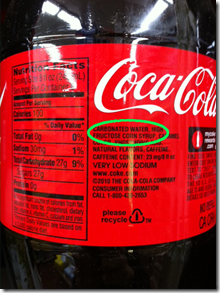 After all, it seems odd to go through the hassle of doing extra processing just to create a sugar that’s similar in so many ways to table sugar. But, as with most things in life, it’s all about the $money$.
After all, it seems odd to go through the hassle of doing extra processing just to create a sugar that’s similar in so many ways to table sugar. But, as with most things in life, it’s all about the $money$.
It surprised me somewhat, but HFCS is generally only used in the US. For example, most Coca Cola sold outside of the US is made from “real” cane sugar, but HFCS is used in US Coca Cola. So why is it cheaper to use HFCS in the US? Shouldn’t the more complicated processing actually make HFCS more expensive?
The answer lies with the US government, which has subsidized corn production forever (ok, not quite literally, but for a very long time). This has resulted in lower HFCS prices than sugar prices. In addition, the US does not limit production of HFCS unlike in Europe, which generally has quotas for the production of HFCS. Because of the price differential, HFCS became the popular sweetener of choice in America. However, its use has steadily declined in recent years due to concerns about its impact on health (although many foods, e.g., Special K and Oreos, still use HFCS).
Is HFCS bad for you?
To keep the suspense level down, I’ll give you the conclusion first. There are a few studies linking HFCS to obesity (most recently, a Princeton study found rats gained more weight eating HFCS than table sugar even when their overall caloric intake was the same) and higher risks of heart disease, but these studies are nowhere close to conclusive (in fact, I’d be highly skeptical of the conclusions drawn in the heart disease study!). In general, whether it’s HFCS or any other type of sugar that they’re putting in, it’s going to add a lot of calories to your diet, and they’re calories that add zero nutritional value to your diet!
Although the studies are pretty inconclusive at this point, it is possible that HFCS is marginally worse for you than table sugar. Many scientists postulate that this difference is due to the higher fructose concentrations in HFCS. Fructose has recently been highlighted by several scientists and health writers as being the worst of the sugars, and this may be a good reason to abandon HFCS, although don’t forget that cane sugar is really not that much better! And if we’re throwing dirt on fructose and anything containing high levels of fructose, then we should also be worried about honey (which contains more fructose than glucose) and agave (which is mostly fructose, almost 90%). So, while the media and public opinion paints devil horns on any products containing HFCS, maybe you should be considering what you’re sweetening your foods and drinks with…it may be even worse for you than HFCS.
P.S. In a last ditch attempt to save HFCS, the corn industry is planning to rename it to “corn sugar” to curb “consumer confusion.” Do you think this new name will make you feel safer about consuming the product? Feel free to comment below.
Caffeine Addiction or Chemical Overload – Could Decaf be More Chemically Dangerous than Caffeine?
 Mmmmmm….Decaf. Same great taste, same great chemicals? For a long time, I’ve drank decaf beverages without really giving a second thought to how my drink came to be “decaffeinated.” They grow decaf tea leaves and coffee beans, right? Right?
Mmmmmm….Decaf. Same great taste, same great chemicals? For a long time, I’ve drank decaf beverages without really giving a second thought to how my drink came to be “decaffeinated.” They grow decaf tea leaves and coffee beans, right? Right?
Not quite. Benzene, methylene chloride (dichloromethane), trichloroethylene, and ethyl acetate are all chemicals that have been or are used in the decaffeination process of tea, coffee, and kola nuts (those things that make coca cola taste so amazing!). Somehow, knowing their names makes that previously delicious cup of decaf suddenly sound a little more like a brew of hazardous toxins.
I’m an avid drinker of tea, and although my favorite saying is “While there is tea, there is hope,” I am also an avid believer of “8 hours of sleep a night will keep the crankiness out of sight!” So despite the many sneers of “What’s the point of decaf?” I keep my cupboards well stocked with decaffeinated tea and occasionally even decaf coffee and diet coke! I was therefore quiet a bit alarmed when I heard that the process of decaffeination introduced a slew of unwelcome chemicals into my teapot.
So, is Decaf Safe to Drink?
I’m going to lead you through all the different methods of decaffeination – sometimes it gets a bit technical as there’s a slew of information out there. This is more like the definitive guide to decaffeination rather than a simple regurgitation of the Wikipedia entry, but I’ve highlighted the main issues in each paragraph so that you can just skim through if you’re not all that particular about your decaf beverage. Let’s start with the different ways that beverages have been or are decaffeinated.
- Benzene: Decaffeination has been around for a long time. Ludwig Roselius and Karl Wimmer discovered a method involving benzene back in 1903, which marked the first commercially successful
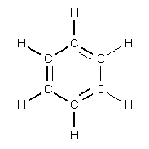 decaffeination process. There was a problem with benzene, however. Although benzene is a highly useful chemical commonly found in crude oil, it has been directly linked to cancer as well as other illnesses such as leukemia and other bone marrow problems. Scared? Yeah, you should be! Thankfully, benzene is no longer used to remove caffeine. Also banned is trichloroethylene, another organic solvent that had been used in decaffeination.
decaffeination process. There was a problem with benzene, however. Although benzene is a highly useful chemical commonly found in crude oil, it has been directly linked to cancer as well as other illnesses such as leukemia and other bone marrow problems. Scared? Yeah, you should be! Thankfully, benzene is no longer used to remove caffeine. Also banned is trichloroethylene, another organic solvent that had been used in decaffeination.
- Methylene chloride: We’ve now jumped to the present and a commonly used solvent known as methylene chloride or dichloromethane, which is colorless and possesses a sweet aroma. During the decaffeination process, the coffee beans or tea leaves are first steamed to draw the caffeine in them to the surface. Methylene chloride is then used to wash the caffeine from the beans or leaves. This process works because caffeine, but not the coffee or tea flavor, dissolves into the chemical. Although most of the chemical is removed by evaporating it off, minute traces of methylene chloride is left on the coffee or tea (I’ve seen unconfirmed sources of 1 part in a million thrown about recently. Both the US and the UK only permit a maximum of 5 parts per million). Should we be worried about 1 part in a million? Methylene chloride is common in many households products, ranging from paint stripper to pesticides. As a result, we are often exposed to it (11 parts per billion parts of air in some urban areas and waste sites according to the US Dept of Health and Human Services’ 2000 toxicology profile for methylene chloride).
So is it safe? Yes, unless you somehow drink 10,000 cups of coffee per day. High concentrations of methylene chloride can cause nausea, numbness of extremities, and even unconsciousness and death, but when I say “high concentrations,” I mean seriously high concentrations! The toxicology profile indicates that levels over 10,000 parts per million in one sitting – that’s around 10,000 cups of coffee or tea in one day – have caused death and illnesses in some animals. A study in the Journal of the American Medical Association found: “Studies of rats fed regular and decaffeinated coffee (at doses equivalent to 70 or 80 cups of coffee a day) or fed methylene chlorine in their drinking water (at doses equivalent to 125,000 to 6,250,000 cups of decaffeinated coffee a day) showed no evidence of carcinogenicity.” Convinced yet? I think like many consumers, the mere mention of chemicals even if just trace amounts may make your heart start racing. That’s probably why the imported decaf tea I drink, Typhoo (a British
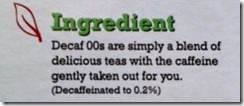 brand), doesn’t mention methylene chloride anywhere on the packaging or on their website – instead, they call it “gently” taking out the caffeine (see photo) and “a technique to wash the tea” (see their website). (Incidentally, Tetley and PG Tips both also use this same process of decaffeination). If you’re not British, then you’re probably more worried about coffee. Many brands of decaf coffee will be made using the methylene chloride method, and there’s no way to know except to check each brand (if you’re that paranoid despite what I’ve just told you about it being completely safe!). In case you are paranoid, Starbuck’s website lists Decaf Sumatra as being made using the carbon dioxide process discussed below, which doesn’t use any “chemicals” unless you’re also paranoid about CO2. I haven’t seen any definitive answer regarding other brands of Starbucks decaf although this website claims that as of 2009 all of Starbuck’s decafs were processed using methylene chloride.
brand), doesn’t mention methylene chloride anywhere on the packaging or on their website – instead, they call it “gently” taking out the caffeine (see photo) and “a technique to wash the tea” (see their website). (Incidentally, Tetley and PG Tips both also use this same process of decaffeination). If you’re not British, then you’re probably more worried about coffee. Many brands of decaf coffee will be made using the methylene chloride method, and there’s no way to know except to check each brand (if you’re that paranoid despite what I’ve just told you about it being completely safe!). In case you are paranoid, Starbuck’s website lists Decaf Sumatra as being made using the carbon dioxide process discussed below, which doesn’t use any “chemicals” unless you’re also paranoid about CO2. I haven’t seen any definitive answer regarding other brands of Starbucks decaf although this website claims that as of 2009 all of Starbuck’s decafs were processed using methylene chloride. - Ethyl Acetate or “Natural” Decaffeination: The word “natural” probably piqued your interest, although placed alongside “ethyl acetate,” it probably confused you a bit. Well, it’s “natural” because ethyl acetate occurs naturally in fruits. The process itself is similar to that explained above for methyl chloride (i.e., ethyl acetate is just used to wash the caffeine away). I haven’t found any coffee or tea brands that admit to using this process, but that may be because ethyl acetate not only takes out most of the antioxidants along with the caffeine but also imparts a chemical taste to the coffee/tea.
Are there any non-chemical methods of decaffeination? If you’re paranoid, then you’ll be happy to know that there are several non-chemical processes that a lot of companies are using these days.
- Carbon dioxide process: Pre-steamed tea leaves or coffee beans are soaked for 10 hours in a semi-liquid form of CO2 in a pressurized chamber. (CAUTION: this gets scientific here…) The CO2 binds to the caffeine molecules but leaves the flavor molecules mostly intact (although 8% of antioxidants may be removed). Then after the soaking is complete, the pressure is reduced and the CO2 evaporates and is removed along with the caffeine. You’re probably jumping for joy right now – why don’t we use CO2 to decaffeinate all teas and coffees? Well, how much do you want to pay for your precious cup of tea or coffee? Unfortunately, the high pressure required to keep the CO2 in a semi-liquid form for 10 hours does not come with a low price tag. But if you’re willing to pay for peace of mind, then go ahead. Most manufacturers that use the process happily advertise the fact. For example, I also sometimes drink Allegro’s decaf black tea and that’s decaffeinated using this process (see photo).
- Swiss Water Process of Decaffeination: You can decaffeinate with water?? Again, why doesn’t everyone just use this process?? Well, like the CO2 method, it’s also not that common and fairly expensive. Exposure of coffee beans to water multiple times may cause diminished flavor. This process is generally also only used for coffee decaffeination and not for tea. The process is not as simple as you might think and involves several stages of caffeine removal. I’ll try not to bore you with the science, but the basic process is placing the coffee beans in a caffeine-free coffee extract water. This then allows the caffeine to diffuse from the coffee beans into the caffeine-free liquid while keeping the coffee flavors in the beans because there’s already so much coffee flavors in the water. This is repeated over and over again to remove most of the caffeine. If you want a more in-depth yet understandable explanation, try this website.
Can’t I just brew the caffeine out of tea at home? I’ve read numerous sites claiming that you can decaffeinate tea yourself by throwing away the first brew of the tea. Of course, this isn’t really possible with many weak tea brands (I need to use 2 Lipton tea bags just to brew one small cup of barely drinkable tea!). While many websites suggest that it takes a mere few seconds for the caffeine to seep out of the tea, there is a very authoritative article citing studies suggesting that it will take 15 minutes of brewing before close to 100% of the caffeine is removed (30 seconds will remove only 10-20% of the caffeine). So while you can make your own cuppa decaf tea, you will also end up drinking some serious weak crap – you might as well drink hot water! It’s also possible (to a limited degree) to make a decaf your own coffee at home using the Swiss water process, but it’s rather complicated (see this website if you’re interested).
Hey, what happened to decaf soft drinks? Oh yeah, I nearly forgot about that! Did you forget what a can of coke contains? Chemicals… and you’re asking whether the chemicals in the decaffeination process is going to kill you? Well, many soft drinks actually add in caffeine extracted from the decaffeination process so I suspect that the decaf variety of those soft drinks just omit those additions.
I got lost – what’s the conclusion? Yeah, it’s taken me a few days to go through the mountainous amounts of information out there. There’s a lot of negative press about decaf drinks stemming mainly from the previous use of hazardous chemicals such as benzene. However, all the decaffeination processes today are very safe. But we all have our own individual views about what constitutes safe and the beverages industry has reacted to consumer demands for non-chemical methods of decaffeination.
Bottom line – all decaf drinks are safe, but if you jump at the word “chemical” then buy coffee or tea that has been decaffeinated using the CO2 or the Swiss water process.

